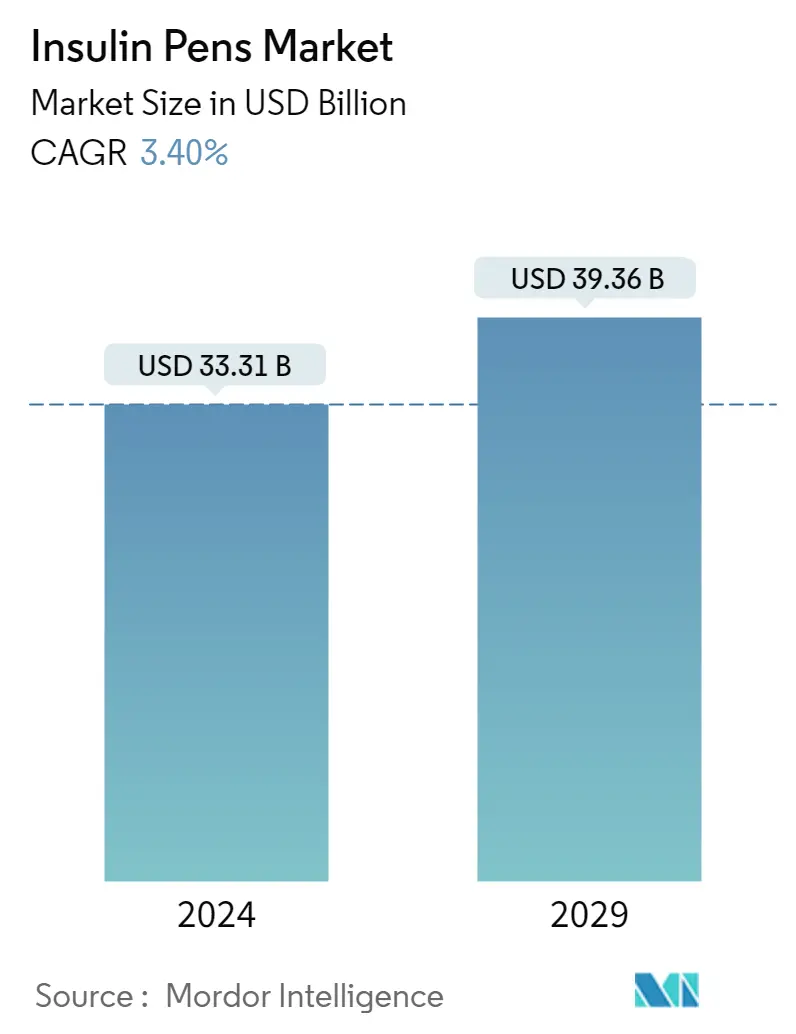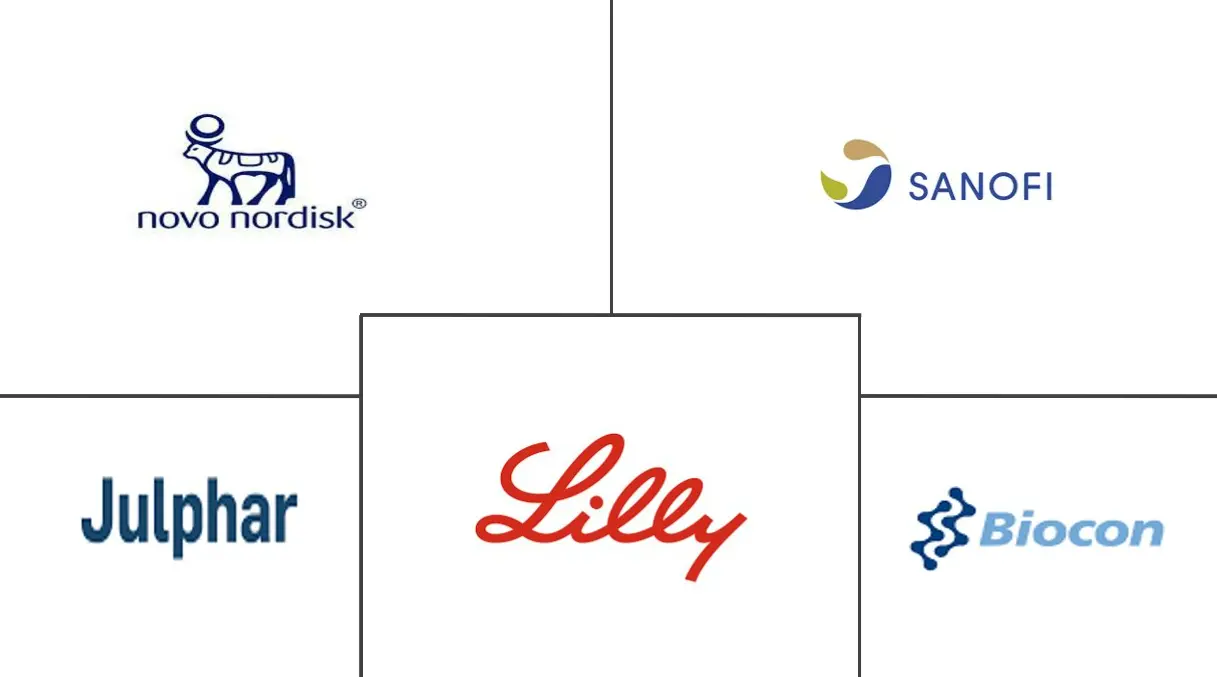Market Size of Insulin Pens Industry

| Study Period | 2018 - 2029 |
| Market Size (2024) | USD 33.31 Billion |
| Market Size (2029) | USD 39.36 Billion |
| CAGR (2024 - 2029) | 3.40 % |
| Fastest Growing Market | Middle East and Africa |
| Largest Market | Asia Pacific |
Major Players
*Disclaimer: Major Players sorted in no particular order |
Insulin Pens Market Analysis
The Insulin Pens Market size is estimated at USD 33.31 billion in 2024, and is expected to reach USD 39.36 billion by 2029, growing at a CAGR of 3.40% during the forecast period (2024-2029).
Diabetes was one of the key comorbidities that were strongly linked to the risk of mortality and unfavorable clinical outcomes in people with COVID-19. People with diabetes were more vulnerable to COVID-19 infection than people without diabetes, and this vulnerability was greater in COVID-19 patients with a severe clinical course, according to numerous epidemiological studies. When diabetic patients or healthcare professionals were required to minimize contact and remain confined during the epidemic, telehealth provided an alternative form of support in averting acute complications and controlling extreme hyperglycemia. It was also recommended that diabetics not infected with the SARS-CoV-2 maintain optimum glycemic control to prevent COVID-19.
Diabetes is generally considered a lifestyle disease. Over time, incidences of the disease have increased with the population worldwide. A disposable insulin pen is a prefilled pen that should be thrown away after a single use. Reusable pens permit the insertion of a pen fill (cartridge), thus allowing repeated usage. The needles on a reusable pen should be replaced periodically. Insulin Pens (disposable and reusable) are the most widely used devices for administering insulin among diabetic patients, mostly in developed countries. The ease of use and accuracy in administration make insulin pen usage high among insulin users. Insulin has been used in treating diabetes for over 90 years globally. Even then, half of those who need insulin today still cannot afford and access it. People with Type 1 diabetes need insulin therapy, and the treatment focuses on managing blood sugar levels with insulin, diet, and lifestyle to prevent complications.
Insulin Pens Industry Segmentation
A needle-equipped injecting tool called an insulin pen injects insulin into the subcutaneous tissue (the tissue between the skin and muscle). The Insulin Pens Market is set to witness a CAGR of more than 3% during the forecast period.
The insulin Pens Market is segmented by product (Disposable Insulin pens and Cartridges in Reusable Pens) and by geography (North America, Europe, Asia-Pacific, Middle East and Africa, and Latin America). The report offers the value (in USD million) and volume (in Units million) for the above segments.
| By Product | |
| Reusable pens (Cartridge) | |
| Disposable Pens |
| Geography | |||||||||||||
| |||||||||||||
| |||||||||||||
| |||||||||||||
| |||||||||||||
|
Insulin Pens Market Size Summary
The insulin pens market is poised for steady growth over the forecast period, driven by the increasing prevalence of diabetes globally. This market encompasses both disposable and reusable insulin pens, which are essential for insulin administration among diabetic patients, particularly in developed regions. The rise in diabetes cases, often linked to lifestyle factors, has been significant, with type 2 diabetes becoming more common across various income levels. The COVID-19 pandemic highlighted the vulnerability of diabetic patients, emphasizing the need for effective glycemic control and the role of telehealth in managing diabetes during periods of restricted contact. Despite the long-standing use of insulin in diabetes management, access to affordable insulin remains a critical challenge, especially in low- and middle-income countries where the majority of diabetic individuals reside.
The Asia-Pacific region is expected to experience notable market expansion due to its aging population and rising diabetes prevalence, exacerbated by lifestyle changes and increased stress levels. The region's production infrastructure for anti-diabetic medications also contributes to market growth. However, the high cost of pharmaceuticals poses a significant commercial challenge. The market is characterized by a consolidated structure, with a few major manufacturers dominating globally, while others focus on regional markets. Innovations and technological advancements in insulin delivery devices, such as smart insulin pen caps and personalized diabetes management platforms, are anticipated to drive market expansion. These developments underscore the ongoing efforts by leading manufacturers to enhance product offerings and capture a larger market share.
Insulin Pens Market Size - Table of Contents
-
1. MARKET DYNAMICS
-
1.1 Market Overview
-
1.2 Market Drivers
-
1.3 Market Restraints
-
1.4 Industry Attractiveness - Porter's Five Forces Analysis
-
1.4.1 Threat of New Entrants
-
1.4.2 Bargaining Power of Buyers/Consumers
-
1.4.3 Bargaining Power of Suppliers
-
1.4.4 Threat of Substitute Products
-
1.4.5 Intensity of Competitive Rivalry
-
-
-
2. MARKET SEGMENTATION
-
2.1 By Product
-
2.1.1 Reusable pens (Cartridge)
-
2.1.2 Disposable Pens
-
-
2.2 Geography
-
2.2.1 North America
-
2.2.1.1 United States
-
2.2.1.2 Canada
-
2.2.1.3 Rest of North America
-
-
2.2.2 Europe
-
2.2.2.1 Germany
-
2.2.2.2 United Kingdom
-
2.2.2.3 France
-
2.2.2.4 Russia
-
2.2.2.5 Spain
-
2.2.2.6 Italy
-
2.2.2.7 Rest of Europe
-
-
2.2.3 Asia Pacific
-
2.2.3.1 India
-
2.2.3.2 China
-
2.2.3.3 Japan
-
2.2.3.4 South Korea
-
2.2.3.5 Australia
-
2.2.3.6 Vietnam
-
2.2.3.7 Malaysia
-
2.2.3.8 Indonesia
-
2.2.3.9 Philippines
-
2.2.3.10 Thailand
-
2.2.3.11 Rest of the Asia-Pacific
-
-
2.2.4 Latin America
-
2.2.4.1 Brazil
-
2.2.4.2 Mexico
-
2.2.4.3 Rest of Latin America
-
-
2.2.5 Middle-East and Africa
-
2.2.5.1 Egypt
-
2.2.5.2 Saudi Arabia
-
2.2.5.3 Iran
-
2.2.5.4 South Africa
-
2.2.5.5 Oman
-
2.2.5.6 Rest of the Middle-East and Africa
-
-
-
Insulin Pens Market Size FAQs
How big is the Insulin Pens Market?
The Insulin Pens Market size is expected to reach USD 33.31 billion in 2024 and grow at a CAGR of 3.40% to reach USD 39.36 billion by 2029.
What is the current Insulin Pens Market size?
In 2024, the Insulin Pens Market size is expected to reach USD 33.31 billion.

